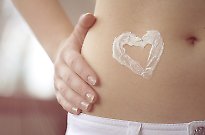
What is endometriosis?

How you can treat, heal and recover.
Dr Nat Kringoudis shares her advice on all things to do with endometriosis.
Endometriosis is a condition where menstrual blood makes its way into the tissue surrounding the uterus, where it simply shouldn’t be. Because of this, it can’t readily exit the body. It’s literally blood that’s stuck or wedged in the body. Through this image, you can imagine how symptoms of endometriosis develop. Stuck objects are painful. Endometriosis is characterised by:
- painful periods
- clotting menstrual flow
- spotting before the period
- lumps or nodules in the lower abdomen
- bowel troubles (not limited to period time)
- pain with intercourse
- fertility troubles
Many women diagnosed with endometriosis are told that pregnancy will be difficult. I’ve found this to be untrue for my patients, as together we can always work out how to treat their condition. Given the right care, healing is absolutely possible.
What’s more, I’d go as far to say that endometriosis is a lifestyle condition. Our environment, diet and lifestyle absolutely shapes who we are – endometriosis is one way your body is telling you it’s pretty unhappy with your current style of living.
I find it fascinating that in our modern world there are such large gaps in scientific knowledge. We don’t fully know why endometriosis happens. But here’s what we know for sure: endometrial tissue travels down through the uterus and out through the cervix. Blood also may travel upward through the fallopian tubes and out into the peritoneal cavity. It’s only a small amount of blood that may travel upward but may carry with it old bits of the endometrial lining. Women who experience extremely painful menstrual cramps are more likely to lose menstrual flow up towards the fallopian tubes. At this point, the blood (and tissue) will either be reabsorbed or may remain and establish itself somewhere within the pelvic cavity – in reality this shouldn’t be here. If the body is too weak to reabsorb the blood, stagnation will occur; this is endometriosis.
The endometrial tissues that grow outside the uterus will either be non-pigmented or pigmented (containing blood vessels). Pigmented tissue begin to act like uterine endometrium at period time, which means it reacts to hormones and behaves just like the uterine lining does each month as it prepares to shed – which we experience as monthly bleeding. This type of endometriosis is the most likely to be marked by pain. Non-pigmented types of endometriosis may be associated with fertility trouble for reasons not fully understood.
How to treat endometriosis
There are things you can do to treat endometriosis that don’t involve surgery. But whether you are having surgery or not, it’s important to make changes to your diet and lifestyle to keep it from either coming back or getting worse. Anything inflammatory will worsen endometriosis. Foods that cause inflammation and disrupt gut function include:
- refined foods (like fast food)
- spicy foods
- dairy
- meat (if poorly prepared)
- sugars/fructose
Diet
Cold, raw foods can aggravate and worsen symptoms of endometriosis. I ask my clients to experiment and try four weeks of limiting raw and refrigerated foods. Remember that your body speaks to you through symptoms, so if you find that by doing this your digestion and menstrual symptoms are lessened, continue with it for at least three menstrual cycles to really allow the body to heal.
Stress
Just like with PCOS, any stress load on the body will worsen symptoms. This extends to exercise, emotional wellness and general lifestyle. Gentle to moderate exercise is much better for you than high intensity. Physical activity will help to manage endometriosis for many women, as it assists in moving the stuck endometrial blood out of the body.
Female hygiene
Finally, feminine hygiene products need to be considered. It’s been reported that women who use organic, toxin-free sanitary products noticed improvement with the level of pain and clotting during their periods. Anything that irritates the body will lead to inflammation and pain, so I always recommend organic pads to women with endometriosis. Using tampons may contribute to limiting and hampering blood flow.
There are a few more tips I suggest to those with endometriosis.
Consider:
- abdominal massage
- meditation (especially to help with pain management)
- building emotional health
- simple heat packs over the lower abdomen to encourage blood flow
In a nut shell – balancing your hormones and moving towards wellness doesn’t necessarily differ between diagnosis. The same lifestyle approach applies no matter what – whether it is endometriosis, PCOS or hormone imbalance. Our bodies thrive with love and care and all it takes is a shift in mindset to begin your journey towards greater wellness.
Get your hands on a copy of PCOS & Endometriosis explained by Dr Kringoudis and Your Tea for more.


